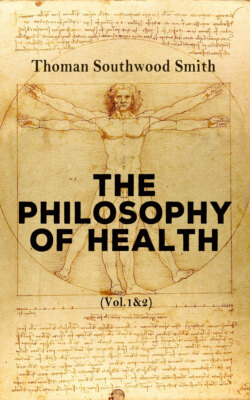The Philosophy of Health (Vol. 1&2)

Реклама. ООО «ЛитРес», ИНН: 7719571260.
Оглавление
Thoman Southwood Smith. The Philosophy of Health (Vol. 1&2)
The Philosophy of Health (Vol. 1&2)
Table of Contents
Volume I
INTRODUCTION
CHAPTER I
CHAPTER II
CHAPTER III
CHAPTER IV
CHAPTER V
CHAPTER VI. OF THE BLOOD
CHAPTER VII. OF THE CIRCULATION
Volume II
CHAPTER VIII. OF RESPIRATION
CHAPTER IX
CHAPTER X. OF THE FUNCTION OF DIGESTION
CHAPTER XI. OF SECRETION
CHAPTER XII. OF THE FUNCTION OF ABSORPTION
CHAPTER XIII. OF THE FUNCTION OF EXCRETION
CHAPTER XIV. OF NUTRITION
Отрывок из книги
Thoman Southwood Smith
Illustrated Edition
.....
But this contrivance will not do when the animal is of large magnitude; when its body is divided into numerous compartments; when these compartments extend far beneath the external surface; when important organs are placed in deeply-seated cavities; and when the substances that compose the organs are dense, hard, thick, and convoluted. To construct air-tubes of the requisite diameter and length, always open, always in a condition to permit the ingress and egress of an adequate current of air to and from the remotest nook and corner of a body such as this, would be difficult, if not impossible. At all events, it is easier, in such a case, to carry the food to the air, than the air to the food. But, for the accomplishment of this purpose, what is necessary? An organ for containing food; an organ for containing air; vessels to carry food to and from the receptacle of the aliment; vessels to carry air to and from the receptacle of the air; expedients to expose a stream of food to a current of air; and, finally, tubes to carry out to the system the product of this complicated operation. Accordingly, a reservoir of food and a reservoir of air; an apparatus by which both are conveyed to their respective receptacles; and an apparatus by which both are brought into contact sufficiently close to admit of their mutual action, are all combined in the lung of the animal, and in the mechanism by which its movements are effected. The object is accomplished, but the apparatus by which it is effected is as complex in structure as it is efficient in action; the result simple; the means by which the result is secured, highly complicated.
And if this be true of an inferior or organic function, it is still more strikingly true of a superior or animal function. The relation is still stricter between the complexity of the apparatus of sensation and the range of feeling, than between the complexity of the apparatus of respiration and the range of the respiratory process. The greater the number of the senses, the greater the number of the organs of sense; the more accurate and varied the impressions conveyed by each, the more complex the structure of the instrument by which they are communicated; the more extended the range of the intellectual operations, the larger the bulk of the brain, the greater the number of its distinct parts, and the more exquisite their organization. From the point of the animal scale, at which the brain first becomes distinctly visible, up to man, the basis of the organ is the same; but, as the range of its function extends, part after part is superadded, and the structure of each part becomes progressively more and more complex. The evidence of this, afforded by comparative anatomy, is irresistible, and the interest connected with the study of it can scarcely be exceeded.
.....